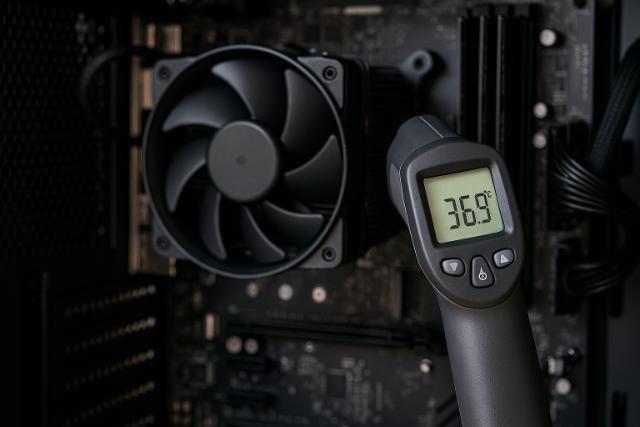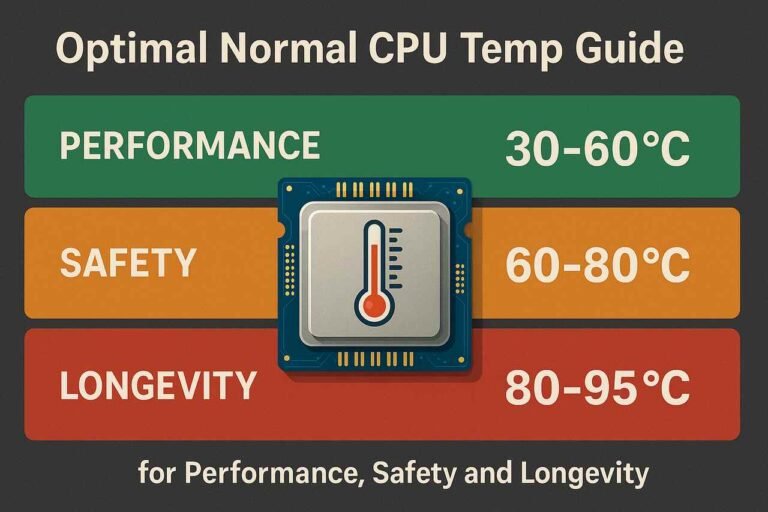Understanding the normal CPU temp range is essential for keeping a computer stable, responsive, and long lasting. Temperature affects processor behavior, power efficiency, and overall system health, making it a crucial factor for both everyday users and advanced builders. This guide explains the practical steps needed to measure, manage, and maintain a stable thermal environment, ensuring that any processor runs at safe and efficient temperatures.
Evaluate Typical Temperature Ranges
Determining a normal CPU temp begins with recognizing the acceptable values during idle, moderate use, and full load. A healthy temperature range allows the processor to function without throttling or long term stress. Most modern processors operate safely within a broad range, but knowing the specific target for your system prevents unnecessary risk. By establishing these baseline values early, you can detect abnormalities before they cause damage.
Several factors influence the acceptable thermal range, such as architecture, voltage, workload, and cooling type. Laptops usually have warmer baselines due to compact designs, while desktops offer better airflow and lower averages. Gaming loads, rendering tasks, virtual machines, and multitasking all produce varying levels of heat output, so evaluating these conditions helps you match the right expectations to your system.
Maintaining temperatures within verified limits ensures consistent performance throughout demanding sessions. As load increases, your computer may adjust clock speeds to avoid overheating. These adjustments affect responsiveness and system longevity, making temperature knowledge crucial for preventing unintended slowdowns or thermal fatigue.
Idle Temperature Expectations
Idle values usually fall between low and mid temperature levels, depending on the CPU model and cooler efficiency. Most processors rest comfortably around cooler ranges when no high workloads are active.
Load Temperature Expectations
Load temperatures reflect the maximum heat produced during heavy processing tasks. Higher readings indicate the need for improved cooling or airflow adjustments.
Measure Your Current Temperatures

Finding the proper normal CPU temp for your system requires accurate measurement tools. These readings allow you to review real time fluctuations and make informed adjustments. Monitoring software captures idle and load values, giving you insight into possible inconsistencies caused by outdated cooling setups or case restrictions.
Software utilities provide detailed status information that helps you diagnose thermal spikes. Some show voltage levels, fan speeds, and clock adjustments, which reveal how the system responds under stress. These tools are essential for discovering recurring patterns, inconsistencies, or anomalies that may impact performance. Regular monitoring provides a record you can compare over time as hardware ages or workloads evolve.
Reliable measurement helps you identify whether external conditions contribute to temperature shifts. Ambient room heat, airflow obstructions, or dust buildup can gradually raise temperatures without immediate warning. By evaluating your readings consistently, you ensure your system stays within safe limits.
Software Options for Temperature Tracking
Many desktop monitoring programs offer real time temperature readings, graphs, and alerts. These tools help confirm whether your system is performing within expected limits.
BIOS and UEFI Monitoring
Built in firmware tools allow you to check thermal conditions without additional software. These readings provide immediate insight into whether the cooling system is functioning correctly.
Improve Airflow Inside Your Case
Once you understand the normal CPU temp range for your system, airflow management becomes a crucial focus. Balanced airflow removes heat efficiently and prevents hotspots from forming around sensitive components. Proper airflow ensures the incoming cool air circulates effectively, while warm exhaust air leaves the case without obstruction.
Fan placement greatly influences heat movement. Front and bottom fans typically introduce cool air, while top and rear fans push warm air out. A disorganized arrangement can trap heat near the processor, leading to steadily increasing temperatures even at modest loads. Adjusting fan direction and ensuring adequate spacing prevents thermal pockets and supports smoother operation.
Dust buildup is a common cause of rising temperatures over time. It restricts airflow, causes fans to spin faster, and reduces heat transfer efficiency. Routine cleaning helps stabilize temperatures, extending component lifespan and keeping performance consistent across various workloads.
Fan Positioning Techniques
Correctly arranging intake and exhaust fans creates a smooth airflow path. Balanced fan placement helps maintain stable internal temperatures.
Cleaning and Maintenance Practices
Regular dust removal maintains steady airflow and prevents gradual temperature increases. Clean filters, coolers, and vents to maintain optimal performance.
Upgrade Your Cooling Solution
If your normal CPU temp is consistently higher than expected, upgrading your cooling solution may be necessary. Enhanced cooling reduces thermal strain during high demand activities such as gaming, rendering, or hosting multiple programs simultaneously. A robust cooling system keeps the processor stable even under extended heavy load.
Air coolers and liquid coolers both have advantages depending on the system. Larger air coolers provide excellent passive and active cooling abilities, while liquid options offer strong performance in compact spaces or high power builds. Choosing an appropriate cooler requires matching its capacity to the power and heat output of your CPU, ensuring lasting stability.
Improved cooling not only helps reduce temperatures but also protects internal components from prolonged exposure to heat. Cooler temperatures contribute to higher reliability, longer hardware lifespan, and improved performance consistency across various workloads.
Air Cooler Choices
Tower coolers offer exceptional airflow and broad compatibility. Their large heat pipes and fans provide dependable cooling performance
Liquid Cooling Options
Closed loop liquid coolers deliver efficient heat removal in compact designs. Their radiators create effective thermal dispersion even with demanding processors.
Optimize System Load and Performance
Managing system load ensures the normal CPU temp remains stable during intensive processes. When unnecessary programs run in the background, they generate extra heat that can push temperatures higher than needed. Controlling background applications helps the processor remain cool and efficient.
Performance settings affect how hardware responds to heavy tasks. Overly aggressive profiles can push voltage and clock frequencies higher, increasing thermal output. Adjusting performance modes to match your daily use helps maintain a comfortable balance between speed and temperature. For most users, moderate profiles deliver an optimal blend of performance and efficiency.
Limiting demanding tasks and balancing workloads prevents the temperature from rising too rapidly. When intensive processes stack on top of each other, heat accumulates quickly and reduces system stability. Monitoring how your system behaves under different loads helps you keep temperatures within safe limits.
Adjusting Power Settings
Using balanced or efficient power modes reduces thermal output without sacrificing essential performance.
Managing Background Processes
Closing unused applications reduces unnecessary CPU usage and keeps temperatures under control.
Compare Temperature Behaviors Across Systems
Understanding normal CPU temp becomes clearer when comparing different systems, processor generations, and workloads. Various hardware configurations produce unique thermal patterns. This comparison helps identify whether your system behaves as expected or needs attention.
Factors such as cooler size, thermal paste quality, case design, and location all influence temperature readings. Smaller form factor systems naturally run warmer, while large tower cases often maintain cooler baselines. Workloads such as gaming or video encoding generate significantly more heat than simple browsing, typing, or streaming.
Comparing your results with similar setups reveals whether the system is performing within expected thresholds. If your temperatures are significantly higher, you can take targeted action to resolve underlying issues. This helps maintain system reliability, especially under prolonged stress.
Temperature Variations by System Type
Laptops, compact desktops, and full tower PCs all exhibit distinct thermal behaviors. Each design introduces its own airflow and cooling challenges.
Temperature Variations by Workload
Different tasks produce unique heat patterns. High performance uses create higher temporary peaks compared to light daily activities.
Apply Thermal Paste Correctly
Thermal paste plays a vital role in reaching a stable normal CPU temp. It fills microscopic gaps between the processor and cooler base, enabling smooth heat transfer. Without proper application, temperature readings rise quickly due to poor contact.
The quality of the thermal paste affects how well heat moves away from the CPU. Some formulas prioritize longevity, while others focus on high conductivity. Reapplying the paste periodically ensures ongoing performance because old material can dry out, crack, or lose its effectiveness over time. Applying it carefully and consistently results in improved thermal stability.
Correct application ensures even distribution across the processor surface. Too much or too little paste prevents optimal heat transfer. When applied properly, the paste helps maintain controlled temperatures even during long and demanding tasks.
Choosing Thermal Paste Type
Different compounds offer benefits such as long lasting stability or high heat conductivity. Selecting the right one ensures dependable performance.
Reapplication Intervals
Replacing old paste restores efficient heat transfer. Timely reapplication helps prevent rising temperatures and protects internal components.
Temperature Comparison Table
| Usage Scenario | Typical Temperature Range | Influence on Performance |
| Idle | Lower baseline values | Stable and efficient operation |
| Moderate Load | Mid range temperatures | Smooth performance with occasional spikes |
| Heavy Load | Higher operational values | Possible throttling if temperatures exceed limits |
Cooling Method Performance Table
| Cooling Method | Efficiency Level | Ideal Use Case |
| Tower Air Cooler | High | Desktop systems needing robust airflow |
| Liquid Cooler | Very High | High performance builds with limited space |
Conclusion
Maintaining the proper normal CPU temp ensures long lasting performance, stability, and hardware health. By evaluating thermal readings, adjusting airflow, upgrading cooling solutions, managing system load, and applying thermal paste correctly, you create a well balanced environment that supports efficient computing across various tasks. Awareness and consistent monitoring protect your system from overheating and sustain high performance throughout its lifespan.
Explore more insightful and valuable content on our blog journalingtechniques! Stay updated with helpful tips, expert advice, and in-depth articles that enhance your knowledge.
FAQ’s
Most systems handle moderate temperatures comfortably under casual workloads. Values tend to remain stable when airflow and cooling are functioning correctly.
Background programs and boot processes temporarily increase processor activity, which creates a brief rise in heat until the system settles.
Reapplication every couple of years helps maintain efficient heat transfer, especially in systems that run under heavy load or warm environments.
Yes. Demanding visual and processing tasks create significant heat. As long as temperatures stay within recommended limits, peaks are expected.
Blocked vents, dust buildup, or missing fans restrict air movement. These issues trap warm air and raise internal temperatures.
Lowering voltage slightly reduces heat generation. Many users see noticeable temperature improvements without losing stability.

